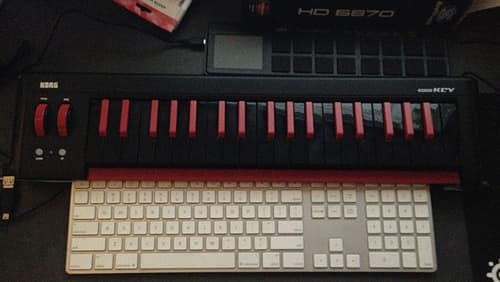M-Audio Keystation Mini 32 vs The Korg MicroKey 37
There’s been a recent development in the past few years, low profile midi controllers, the Korg Nanoseries, Korg MicroKey series the Akia LPK25, Akia MPK, M-Audio Axiom Air Mini 32 and the most full featured, the Axiom Air 25, and not to mention the M-Audio Keystation Mini 32.

Pictured, Korg Nanokontrol2, Korg PadKontrol2 and the M-Audio Keystation Mini 32 and the Apple USB keyboard

Pictured: Korg PadKontrol2 and the Korg MicroKey 37 and the Apple USB keyboard
Features
The Keystation 32 doesn’t go for too much pizazz, its a simple, it has a single “Volume” knob, best used as a mod or pitch bend, octave buttons, sustain button and Pitch Bend Buttons. Its minimalist to say the least.
The Korg Keystation to anyone who’s messed with midi in the past three decades is pretty familiar: Mod, pitch and octaves on the left and keys on the right. Its very reminiscent of the first stand alone controller I bought over a decade ago, a Midiman keyboard. As a bonus, its also a two port USB, which is a very nice addition. The M-Audio does get a point on having a sustain button, as the Korg doesn’t have a sustain button or ¼ inch input.
Winner: Korg (Barely)
Physical Mod and Pitch Bends are much more useful than a volume knob. The MicroKey 37’s little brother, the MicroKey 25 has a sustain button, oddly enough. Why this was left off is beyond me.
Feel
I tested out a few of the competitors, mostly the KeyKontrol2 and the Akia LPK25 in store. The Korg KeyKontrol2 is nearly unusable, the button feel like plastic drum pads and the Akia feel like a toy.
The M-Audio KeyStation mini 32 keys being adequate sized and enough resistance to gauge velocity. Beyond that, I would not describe it as great or even good. Just acceptable. However, for the size there’s no comparison. It’s the best you’re going to get in roughly 15 inches of width.
While, the Korg was stickered at the same price at my local guitar center, the M-Audio Keystation is a cheaper (and much smaller) keyboard, so it comes as no suprise the Korg wins. The Korg keys aren’t semi-weighted like higher end controllers (Axiom/Axiom Pro) but they offer a steady resistance that’s familiar to lower end midi controllers and synths. The keys aren’t full sized but with a much deeper range of motion, it feels less micro and more like another keyboard. It won’t win awards but its, dare I say good.
Winner: Korg
Size
The greatest liberation is not having to put away the keyboard when you’re done. Even on my large desk, space is a premium as there’s multiple monitors to share with it my ever present keyboard and mouse.
I found despite owning an 88 key hammer action keyboard, my preferred piece of hardware was my Axiom 25 for years, despite being an inferior keyboard, simply due to its size. However, its still massive compared to these two keyboards.
The Keystation 32, while wider than the Korg NanoSeries, is still small enough for a backpack. Where portability and space is concerned, the M-Audio wins hands down.
Winner: M-Audio
Final Thoughts
Its best to go to a local dealer to see its right for you. Picky Keyboardists will find the M-Audio lacking and purists will find both woefully inadequate to the weighted hammer action keyboards on the market.
Both keyboards are plug and play. They both worked perfectly fine with both Cubase 6 and Logic X. I’m retiring the Axiom 25 and I’m going to keep the Korg. The Microkey 37 has some baby fat that could be reduced but 3 full octaves is liberating after years of 25 keying.
The M-Audio Keystation sells routinely for $50 at sweetwater where as the Korg MicroKey is $80. The Keystation is an ideal mate for the traveling musician or iPad musician. Its inexpensive enough to make it an addition to anyone’s midi instrument collection.
The Korg is built to be a daily workhorse. True pitch bend and modwheels are tough to beat. The worst mistake is not including some way to either connect a sustain pedal or a button. I had to run a sustain pedal to my Korg padKontrol, and assign it to Midi CC 64 for sustain pedaling.